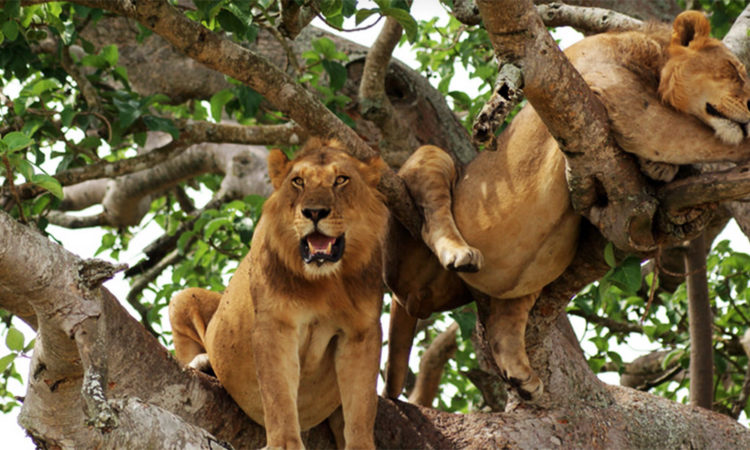Tree Climbing Lions

Tree Climbing Lions
Tree climbing lions can be found the southern part of the ishasha sector of Queen Elizabeth national park. The habit of lions climbing trees is not often.
Queen Elizabeth is the only park in Uganda where tree climbing lions can be found. There instances where people have said they have seen lions climbing trees in Kenya and south Africa, the story seems not to be evident as in Queen Elizabeth park because the lions they see are often young lions playing about tree branches.
However lions can be found in other national parks like Murchison falls, kidepo and others but this don’t climb trees like the ones found in Queen Elizabeth national park apart from Lake Manyara in the neighboring Tanzania.
Tree climbing lions are spotted lazily hanging out in the tree branches and some also fall asleep from up there. The reasons why lions in these savannah plains of Ishasha climb up in the tree branches, are detailed according to research;
• Fleeing from the insect bites. During the rainy season the grounds get infested with the breeding tsetse flies that bite the wild inhabitants, lions inclusive. This makes the lions run to the tree branches for protection from the many insects on the grounds.
• Escaping the heat on the ground. When the seasons change, the savannah tends to have quite high temperatures over 28 degrees Celsius or 80 degrees Fahrenheit. This heat makes the ground extremely hot for the cats. Fortunately, they find places to cool off from there hunt in the tree branches.
• Cool view of the glorious food for these big cats. It’s clear that a view is wide when on a high level than what you what to see. The lions climb up in the tree branches to have a glimpse of their prey, the antelopes, when feeding in the pastures.
For the above reasons, the lions in Ishasha sector in the south of queen Elizabeth national park are “tree climbing” ones.
The climbing lions love the wide branched (candelabrum) trees found in queen Elizabeth national park. These trees include; sycamore fig trees, and acacia trees. It’s this type of trees because they are wide enough providing quiet a comfortable wide place for resting, and are a favorable shelter for the lions during rainy season.
Queen Elizabeth national park is rich in fauna ranging from the candlestick thorns, humid rain forests to the Savannah vegetation which favors most wildlife like the Ugandan kobs, antelopes, warthogs and many more animals seen roaming on the ishasha sector, kasenyi plains, kazinga channel, lakes and around every area of the park including the chimpanzees at kyambura George and other primates
The tree climbing lions don’t climb the trees at dawn except when the sun rises the common trees they climb are; the sycamore fig trees and the acacia trees, the manes of the male lions of Queen Elizabeth are black.
Encountering the special unique lions of Queen Elizabeth is a one in a life time experience you won’t forget more so if you take enough photos back home as they lazily lie in the tree branches or when catching their prey.
The sycamore fig tree is an advantage to the tree climbing lions as they provide enough shelter to the lions from the heat as well as during rainy seasons.
Why Queen Elizabeth national park the ideal place for the tree climbing lions?
Tree climbing lions are the reason for the fame that the southern part of Queen Elizabeth national park (ishasha) gets from the world tourism industry. The tree climbing lions draw 1000s of tourists from all around the world to the national park. They are a star attraction and a breath taking experience for the tourists that visit east Africa.
The tree climbing lions in Lake Manyara Tanzania are rare to find and this might give a bad impression to the tourist that, “maybe it’s just a myth that there are tree climbing lions in Africa”. Unlike, for Ishasha in Queen Elizabeth national park it is a must for a tourist who visits the area to spot quiet a number of them.
The tourists get lost of words and stay amazed when they come to visit Queen Elizabeth national park’s mysterious behaved cats (tree climbing lions) that climb in the top of the trees and hug up there with a lot of ease. A tourist can get to spot over a guestimate of 50 lions sleeping in the trees.
When you spot the tree climbing leopards during one of your game drives, you will assertively confirm the unique characteristic of the big cats of ishasha found in Queen Elizabeth national park- Uganda.
They lazily hung up in the tree branches to take a rest after a day’s hunt to digest their food well. They are also spotted eagerly staring at the small animals feeding on the ground. Thus not only do the trees give the lions a relaxing lobby but also a spying point for their next hunt.
Is it ideal to term these cats/lions as “king” of the African jungles?
Tree climbing lions in Ishasha face a lot of threat from the growing human population around the park. For example, on April /10th/ 2018, 11 lions where found lying dead in ishasha. It’s alleged that they were found with insecticide poison in their caucus.
Other factors are causing to reduction in the population of these unique talented tree climbing lions in queen Elizabeth national park; natural deaths, killings from the dominant male to the cabs among others.
Despite of the fact that these lions are endangered, they still remain a firm attraction for the tourists to this jungle of Africa. They also remain “the king of the jungle”, it’s their historical pride and no one can change that.
Apart from the unique tree climbing lions, queen Elizabeth contains other Africa’s big cats such as leopards and also other animals like buffalos, hyenas, antelopes, elephants and many more.
The rest Queen Elizabeth also offers striking scenic views of a real wilderness from the ranging mountains of Ruwenzori also known as mountains of the moon to the magnificent crater lakes surrounding the park including fresh water bodies like lake Edward and George linked by the vibrant Kazinga channel streamlined with hundreds of hippos, crocodiles and elephants playing with water at noon with the stunning kyambura George where chimpanzees scan be trekked and far away fishing villages to be visited and interact with the locals and get entertained with local dances and check in their gift shops for locally made crafts to take back home.


